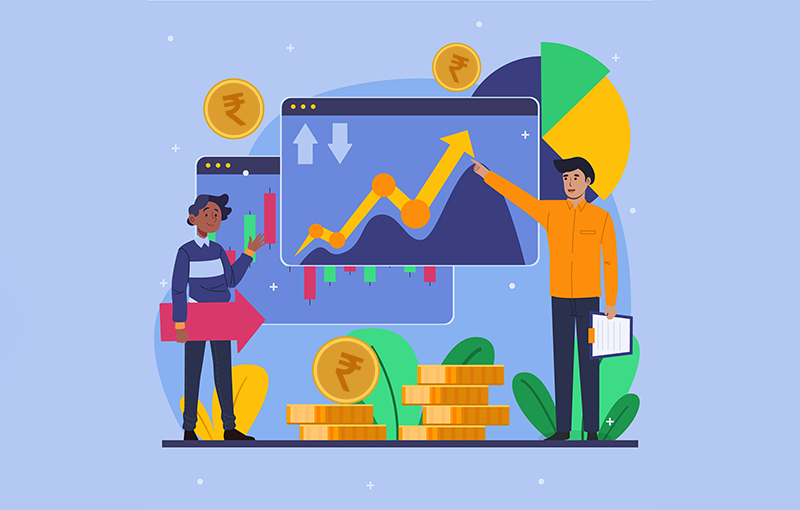Financial Glossary starting with Alphabet D
-
Debt Papers - Duration Management
We have an idea about management of equity funds. Don’t we? Equity Funds are managed by: 1. Identifying stocks based on research. 2. Understanding the macro-economic picture. 3. Selecting the right stocks.
A good fund manager does that and when he does that well, investors stand to make good gains. If this is how equity funds are managed, then how are debt funds managed?
While, on one hand, debt funds invest in debt papers which need to give good fixed returns & be of good quality there is another aspect which is very crucial in debt fund management. And that is ‘Duration Management’ of the debt papers.
Based on the interest rate outlook, the fund manager decides whether he should invest in long duration papers maturing over a period of, say, 10 years or short duration papers maturing over a period of, say, 6 months.
But how is his decision of selecting long duration papers or short duration papers connected with the interest rate outlook?
Simply speaking, when interest rates are expected to go up, the debt fund manager would invest in shorter duration papers but if interest rates are expected to come down, then he would do the opposite and invest in longer duration papers.
However, there is a need to uncover the concept of ‘Duration Management’!
And what better than taking ‘cricket’ as an example? When we think of cricket, the ‘IPL’ comes to our minds in a flash. So what has the IPL achieved?
At one level, it has strengthened the bench strength of the Indian cricket. Today, for example, we have enough fast bowlers, spinners, batsmen etc. Imagine when we went for the recently concluded T-20 World Cup, we had to leave behind Pragyan Ojha, who was the highest wicket taker of the IPL.
So what does this bench strength mean for the BCCI?
At one level, it means that there are enough players available. Hence if the BCCI needs a replacement, they would be available. It also means that BCCI will not want to sign long term contracts with players.
Long term contracts mean long term commitments & with strong bench strength, there is no need for the BCCI to enter into any long term commitments with any player as they have the choice of dipping into the bench whenever current players lose form.
Similarly when the fund manager thinks that the interest rates are likely to go up in the near future, it means that debt papers in the future will offer better rates of return for the investor.
So just like a strong bench strength offered options for BCCI driving them to enter into short term contracts with players, similarly the fund manager observes that since interest rates are likely to rise soon and that debt papers giving a higher interest rates would become available he too would invest in papers with shorter maturities so that by the time the interest rates rise, his papers have matured and he has cash to invest in the new papers.
Now what happens when the debt fund manager believes that interest rates are more likely to come down? He just reverses his strategy and invests in long duration papers.
Now how do we explain this? Let’s once again turn to cricket.
You will recollect that at one point in time a couple of years back the Australian cricket team saw Glenn McGrath, Shane Warne, Mark Waugh, Steve Waugh, Justin Langer all retiring at more or less the same time.
Suddenly there was a dearth of players and the bench strength dried up completely. In such a situation what do you think the Australian Cricket Board could have done?
They would typically get into long term contracts with their players so that they do not lose them to some county or club. The board would thus show more commitment. So even when there is dearth of players the long term contracts signed with the players would stand the board in good stead.
In such a scenario, the value of the player goes up due to the dearth of players. So if some county would want to grab a contracted player, they would have to pay a large price to the Australian Cricket Board for cancelling the contract!
In the same manner, if a debt fund manager feels that interest rates are coming down and that fresh papers in the future would bear lower interest rates, he would naturally invest in currently available papers for a longer duration.
By doing so, his money stays invested in higher interest bearing papers even in a lower interest rate regime.
Just as the value of the cricket player went up when there was a dearth of players and the Cricket Board could extract a price to walk out of the contract, in the same manner the value of the higher interest bearing papers too would go up and the fund manager too could extract a higher price by selling it in the market! (Source: Tata Mutual Fund) -
Debt Fund - why long term when interest falls
Let’s underst why one moves into long term debt funds when interest rate begins to fall.
Every body knows that prices rise when there is increase in demand and fall with the fall in demand. The same is applicable on Bonds with long durations
Let’s also revisit the basics of Bond price and Interest relationship:
When Interest rates rise, price of bonds fall likewise the price rise with the fall in interest rates
Let’s say there is this typical Indian middle class housewife who manages her house efficiently with the money that her husband gives her. When inflation strikes and refuses to subside, she decides to tweak her management style.
For example because she expects that the supply of vegetables are set to decline and hence the price of vegetables are set to rise, she decides to purchase large quantities of vegetables for a longer period.
Now, even if the price of vegetables were to go up, it would not make a difference for her for a reasonably long period as she had purchased for a longer duration because of her expectations that prices are set to rise.
Similarly when interest rates are expected to come down it means that the demand for bonds yielding higher interest rates would increase. Also the supply of bonds with higher interest rates will come down.
Therefore the price of such bonds would go up. So, just like the smart housewife, a smart fund manager would also buy such bonds for a much longer duration so that he can gain from the increase in the price when interest rates go down as per his expectation
Thus whenever interest rates are poised to fall it makes ample sense to buy funds that hold papers of longer duration such as Income Funds / Gilt funds / Dynamic Bond funds
Going back to our housewife example, what do you think she will do when she expects supply of vegetables in the market is likely to go up?
When supply is expected to go up, prices would come down. Hence the housewife does not buy vegetables for the long term any more. She just buys enough for a day or two so that she can take advantage of the falling prices.
Similarly when the fund manager expects that the interest rates are set to rise, he realizes that the prices of bonds are set to fall because of higher supply. So he sells off the long duration papers and moves into short duration papers. This is exactly like what the smart housewife did when she purchased vegetables for a day or two.
Both their objectives being the same – i.e. to have the money to buy at the right time.
Therefore when one is expecting interest rates to rise, it makes sense to invest in funds like Short Term Bond Fund which invests in papers of shorter duration.
This ensures that you are prepared with money to buy Bonds/ Debt Papers when the prices start to fall. (Source: Tata Mutual Fund) -
Derivatives-Market
We will explain through the example of a farmer and a bread manufacturer which does not represent the manner in which we deal with derivative products in the stock markets.
Imagine there were several farmers in market. Perhaps a few thousands with a view that price of the Wheat is going to fall in near future (bearish participants). And several thousand bread manufacturers with a view that price of the wheat is going to rise in the near future (bullish participants)
And a market place where there is free flow of information. It provides a platform to both bullish & bearish participants to execute their trades without even knowing each other or hunting for the counterparties.
So the expected future stock price (price of wheat for the sake of comparison with our previous examples) is known to every farmer and bread manufacturer.
Any farmer trying to extract a higher price will not be able to do so because for the bread manufacturer there are several other farmers to buy from and vice versa.
Since the price is universally known and there are several farmers and bread manufacturers, there is no need to get into individual contracts. There is no need to know who the options/futures buyer is and who the options/futures seller is for it does not make any difference for either party.
The markets also make it possible for either party to deal with several counter parties at the same time. The market thus makes it possible to keep identities of parties to remain confidential with respect to the respective counter parties.
If one were to replace the farmer and bread manufacturer by normal people who have opposite views about the future prices of stocks, what we have is a typical Derivatives Market.
So in a nutshell The basic fundamentals remain the same as we saw in the farmer and bread manufacturer stories, but the market provides a platform for several parties and counter parties to come together to trade over stocks about which information is free flowing
This leads to a single future price for all participants, thereby rendering irrelevant the need to know who the buyer for the seller and vice versa. Despite all of the above, the market system independently has all the necessary information about the market participants. (Source: Tata Mutual Fund) -
Derivatives-vs-Cash
Why is ‘derivative trading’ a form of high gain - high loss trading with minimum investment ?
We know that dividend trading is about a bet on movements of “futures”. For the sake of understanding, you may replace “futures” with price of share. So essentially, one has to take a bet on the movement of share price at the end of the period.
Since one is looking at price movements, one may presume that the share price would perhaps go up or down by a maximum of 10% in this period.
Hence the margin money required to take a bet on price movements would be 10%. Let’s say the price of the share is Rs 100.Hence, if you want to take a bet on the price movement at the end of a period of say 20 days, you will need to deposit margin money of Rs 10 for a share of Rs 100.
Let’s say after 20 days, the share value goes up to Rs 120. (For the sake of understanding, we are ignoring the mark to market impact where daily debit / credit entries are made, as explained in our earlier lessons). At Rs 120, the buyer of the future makes Rs 10 (Rs. 120 – margin Rs.10 = Rs. 110; thus Rs.120-Rs.110 = Rs.10) as net profit per share.
He thus makes a profit of Rs 10 on an investment of Rs 10 which means that the return on investment = 10 (110 -100)/10% (margin money) = 100% returns.
However, please bear in mind that while you can invest in a single share of a company in the spot or cash market, the requirement in the derivative markets is to invest in a diverse basket or lots of the same shares. For example, a basket (which is generally termed used lot size) of say stock “A” would contain say 10 stocks per lot.
Let’s say the cost of “A” in the spot market is Rs. 100; your investment too would be Rs 100 in the spot market whereas in the derivatives market, you would have to invest in a lot of say 10 shares which would be valued at Rs 1000 but since you only need to invest the margin money of say 10% your investment would be the same Rs 100.
However, in this case, you get the opportunity to take a bet on the price movement of 10 shares valued at Rs 100.
Hence, derivative trading is a high gain and high loss trading as compared to trading in a spot market. Also, in derivative trading you do not deal with a single stock, but in a group or lot of shares. Also, In derivatives trading, you do not take ownership of the group of shares. You only get the rights to bet on price movements of the entire group / lot of shares. -
Difference - Large, Mid & Small Cap Funds
The Indian Premier League (IPL) selection process whereby the team owners bid for players bears similarity to how fund managers select stocks. In this lesson we have attempted to use this similarity to explain the difference between large cap, mid cap and small cap stocks.
An attempt to relate the IPL to Mutual Funds to explain the difference between Large Cap, Mid Cap and Small Cap funds.
To understand this let us go back to the IPL.
Players like Pollard, Chris Gayle, Shane Watson, Dale Steyn comprise a bunch of high quality-higher priced players. They are priced higher at the auction and team owners are willing to pay a high price as these cricketers have proven themselves under different conditions and are expected to perform well. Not much research needs to be done about them because they are already champion cricketers.
These higher priced champions are somewhat like Large Cap funds which invest in big and higher priced companies which are expected to do well. But being higher priced, their returns could get muted unless their performance turns out to be exceptional just like that of Chris Gayle.
Then there are players like Murali Kartik, Parthiv Patel, Robin Uthappa, Ashish Nehra, Irfan Pathan, Yusuf Pathan and RP Singh etc. who have played in the past and in that sense have established their credentials and may also play for the Indian cricket team in the future. Not much research is needed but these players are not in any position to charge a premium either. They are expected to do well due to their experience but not as well as the big players who are in prime form or who like Gayle can tear a bowling apart on their day and win matches single handedly.
These players are like the Mid-Cap funds which buy the stock of companies that are established but not having the stature of large cap stocks. Hence they are not as highly priced as large cap stocks. Most are expected to do well while some of them could surprise with their performance and in future may enter the large cap fund portfolio.
However, players like Sanju Samson, Aditya Tare, Mohit Sharma are relatively new. They were given an opportunity to play and prove themselves. Hence they are relatively less pricey. And they did exceedingly well, returning handsome returns in terms of the value to their owners.
Similarly, in Mutual Fund parlance these are like small cap funds that invest in relatively unknown stock some of which have the capacity to deliver surprising results and good returns. Naturally since they are relatively cheaper, their returns may outperform large cap funds.
However while less research may be required for large cap stocks, research needed to identify high quality mid cap and small cap stocks is relatively much more intense. (Source: Tata Mutual Fund) -
Dividends Distribution Surplus
What does it mean when we say that dividends can be paid out of distributable surplus?
Let’s say there is fruit bearing tree gifted to me. The owner of the tree has set one condition. He says that I can earn only from the produce of the tree? This means that I cannot cut the branches of the trees and sell the wood in the market.
So what can I do? I can water the tree, nurture it so that it bears fruits. Now I can certainly sell the fruits in the market.
Similarly SEBI has mandated that dividends should be declared only out of the profits. The profits that a fund earns is called “distributable surplus”









